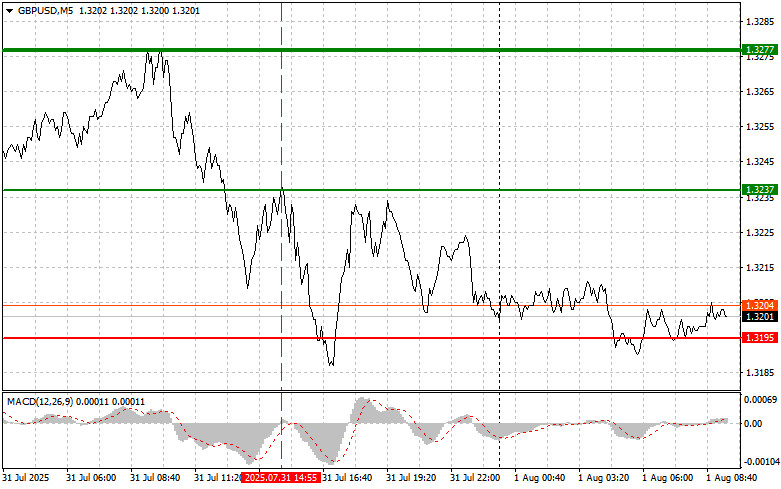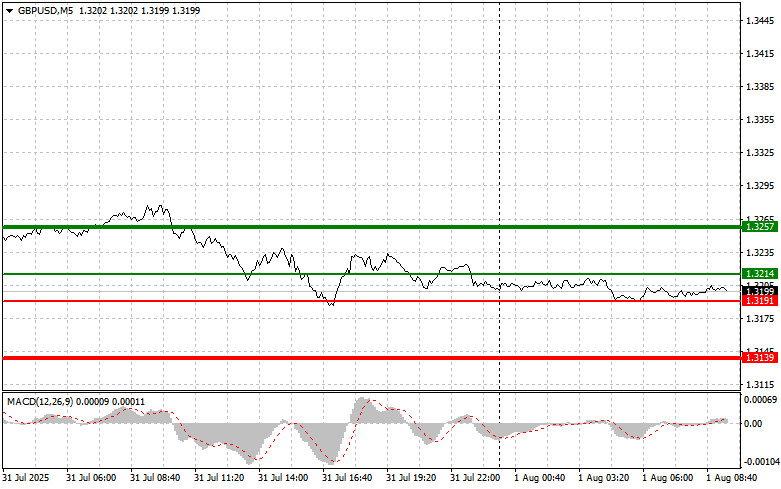Analysis of Trades and Trading Tips for the British Pound
The test of the 1.3237 level occurred at a time when the MACD indicator had just started moving upward from the zero line, confirming a valid entry point for buying the pound. However, the move failed to materialize, resulting in a loss.
Strong U.S. labor market data triggered another wave of sell-offs in the British pound. A resilient U.S. job market strengthened the dollar, making it a more attractive safe-haven asset amid global uncertainty. The Bank of England is already facing a dilemma: on one hand, it must keep inflation in check by maintaining rates at current levels, as inflation targets have not yet been met; on the other hand, it must support economic growth and avoid a recession. Against this backdrop, many expect continued pressure on the pound in the near term until clear signs of economic improvement appear in the UK.
Today, the pound may extend its decline, and even weak data on the UK Manufacturing PMI and Nationwide House Price Index could be enough to trigger further losses. Investors are closely monitoring these key indicators as they provide critical insights into the UK economy. A PMI reading below 50—the threshold between expansion and contraction in the manufacturing sector—would deepen concerns over a slowdown in economic growth, potentially prompting further pound sell-offs as investors seek safer assets. The Nationwide House Price Index is another important barometer, reflecting trends in UK real estate prices. A decline in this index could indicate a cooling housing market, often a precursor to broader economic trouble. Negative real estate data could undermine consumer and business confidence, leading to reduced investment and spending.
For intraday strategy, I will focus primarily on Scenarios #1 and #2.
Buy Scenario
Scenario #1: I plan to buy the pound today at the entry point near 1.3214 (green line on the chart), targeting a rise toward 1.3257 (thicker green line on the chart). Around 1.3257, I intend to exit long positions and open short positions in the opposite direction, aiming for a 30–35 pip pullback from the level. A pound rally today would likely be corrective in nature.
Important! Before buying, ensure the MACD indicator is above the zero line and just beginning to rise from it.
Scenario #2: I also plan to buy the pound if there are two consecutive tests of the 1.3191 level while the MACD is in the oversold zone. This would limit the downside potential and lead to an upward reversal. A rise toward the opposite levels of 1.3214 and 1.3257 can be expected.
Sell Scenario
Scenario #1: I plan to sell the pound today after a break below the 1.3191 level (red line on the chart), which would likely lead to a swift decline. The key target for sellers will be 1.3139, where I plan to exit short positions and immediately open long positions in the opposite direction, aiming for a 20–25 pip reversal from that level. Selling the pound today would align with the prevailing downtrend.
Important! Before selling, ensure the MACD indicator is below the zero line and just beginning to move downward from it.
Scenario #2: I also plan to sell the pound if there are two consecutive tests of the 1.3214 level while the MACD is in the overbought zone. This would limit the upside potential and lead to a downward market reversal. A drop toward the opposite levels of 1.3191 and 1.3139 can be expected.
What's on the Chart:
- The thin green line represents the entry price where the trading instrument can be bought.
- The thick green line indicates the expected price level where a Take Profit order can be placed, or profits can be manually secured, as further price growth above this level is unlikely.
- The thin red line represents the entry price where the trading instrument can be sold.
- The thick red line indicates the expected price level where a Take Profit order can be placed, or profits can be manually secured, as further price decline below this level is unlikely.
- The MACD indicator should be used to assess overbought and oversold zones when entering the market.
Important Notes:
- Beginner Forex traders should exercise extreme caution when making market entry decisions. It is advisable to stay out of the market before the release of important fundamental reports to avoid exposure to sharp price fluctuations. If you choose to trade during news releases, always use stop-loss orders to minimize potential losses. Trading without stop-loss orders can quickly wipe out your entire deposit, especially if you neglect money management principles and trade with high volumes.
- Remember, successful trading requires a well-defined trading plan, similar to the one outlined above. Making impulsive trading decisions based on the current market situation is a losing strategy for intraday traders.














